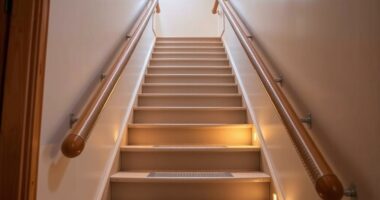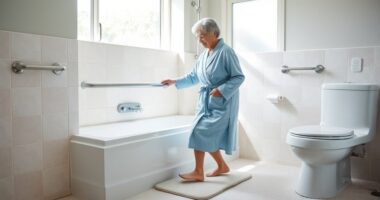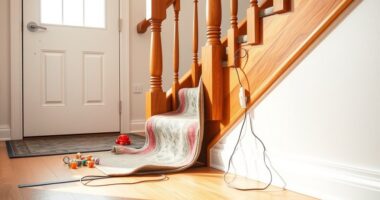To prevent slips and falls in your bathroom, guarantee surfaces are dry and clean, especially after showering. Use non-slip mats with suction cups and install sturdy grab bars near the toilet and shower for added support. Regularly check safety devices for stability and replace worn mats promptly. Proper lighting and wearing non-slip footwear can also help reduce risks. Keep hazards minimal, and you’ll find ways to make your bathroom safer—explore more tips to protect yourself further.
Key Takeaways
- Install non-slip mats and suction cup rugs to improve traction on wet bathroom floors.
- Use grab bars and bathtub grips for stable support during bathing and transfers.
- Keep bathroom surfaces dry and wipe up water immediately to prevent slipping hazards.
- Ensure proper lighting to enhance visibility and reduce accident risks.
- Regularly inspect and maintain safety devices and flooring for secure, effective protection.

Bathrooms can be hazardous if you’re not careful, but with a few simple safety measures, you can prevent accidents and injuries. Slips and falls are common in this space, especially when surfaces become wet and slippery. The good news is that you can substantially reduce this risk by making a few changes to your bathroom setup. One of the easiest and most effective steps is to use bathtub grips and non-slip mats. These simple additions provide extra traction, giving you a secure footing while entering, exiting, or moving around in the tub or shower.
Bathtub grips are designed to be installed inside the tub, usually on the wall or the floor, offering a sturdy handhold as you step in or out. They’re especially helpful for older adults, individuals with mobility challenges, or anyone prone to losing balance. Installing bathtub grips is straightforward, and they don’t take up much space, but they can make a huge difference in safety. When combined with non-slip mats, they create a safer environment that minimizes the chances of slipping during a shower or bath.
Non-slip mats are versatile and can be placed directly on the bathroom floor or inside the tub. These mats are made with textured surfaces that grip your feet, preventing slips even when water or soap creates a slick surface. For added safety, look for mats with suction cups underneath to keep them firmly in place. Regularly cleaning and inspecting these mats ensures they maintain their grip and don’t become a safety hazard themselves. Replace them if they start to peel or lose their non-slip properties.
Beyond mats and grips, consider other safety measures like installing grab bars near the toilet and shower area, ensuring proper lighting, and keeping the floor dry. Always wipe up water immediately after showering or bathing, and avoid rushing or making sudden movements in the bathroom. Wearing sturdy, non-slip footwear when walking in the bathroom can also help prevent falls. Additionally, understanding risk management strategies for bathroom safety can further help in reducing accidents. These small precautions work together to create a safer environment.
Frequently Asked Questions
How Can I Improve Bathroom Lighting for Safety?
To improve bathroom lighting for safety, you should install bright, energy-efficient LED lights that illuminate the entire space. Consider adding motion sensors for convenience and better visibility. Make certain your bathroom has proper bathroom ventilation to prevent moisture buildup, which can cause slippery surfaces. Also, install shower seat options with good lighting nearby so you can safely sit and get ready. Adequate lighting and ventilation make your bathroom safer and more comfortable.
Are Non-Slip Mats Effective on Bathroom Floors?
Yes, non-slip mats are effective on bathroom floors when you maintain them properly. Regularly clean the mats to guarantee slip resistance isn’t compromised by soap scum or mold buildup. Check for wear and tear, replacing them when the traction diminishes. Using these mats can considerably reduce slips and falls, especially in wet areas. Proper mats maintenance keeps the slip resistance high, providing safer footing every time you step into the bathroom.
What Are the Best Grab Bar Placements?
You should install grab bar types like straight, angled, or flip-up bars in strategic spots. Place them near the toilet, inside and outside the shower, and beside the bathtub for easy access. Use sturdy anchors and follow installation tips like securing bars into wall studs and avoiding drywall-only mounts. Proper placement guarantees safety and stability, helping you prevent slips and falls confidently in your bathroom.
How Often Should I Check Bathroom Fixtures for Hazards?
You should check bathroom fixtures for hazards at least once a month as part of your routine hazard inspection. Regular maintenance routines help identify loose grab bars, leaks, or broken tiles early, preventing accidents. Always look for signs of wear, corrosion, or instability, and fix issues promptly. Frequent inspections guarantee your bathroom remains a safe environment, reducing the risk of slips and falls.
Are There Specific Flooring Materials Safer Than Others?
Did you know that textured flooring can reduce slip-and-fall accidents by up to 50%? When choosing bathroom flooring, opt for slip resistant coatings or textured surfaces like vinyl or rubber, which provide better grip, especially when wet. These materials help prevent slips and falls, making your bathroom safer. Avoid smooth tiles that can become slippery, and regularly check your flooring for wear to maintain safety.
Conclusion
Think of your bathroom as a ship steering calm and stormy seas. With careful precautions—like non-slip mats and grab bars—you become the skilled captain steering clear of hidden dangers. When you prioritize safety, you create a safe harbor for everyone aboard. So, take charge today, and turn your bathroom into a fortress against slips and falls. Your vigilance keeps everyone safe, turning potential disasters into smooth sailing.









